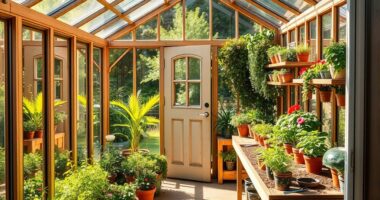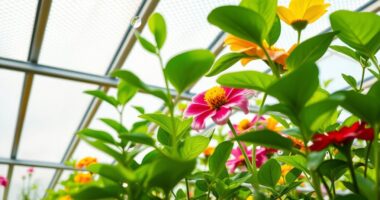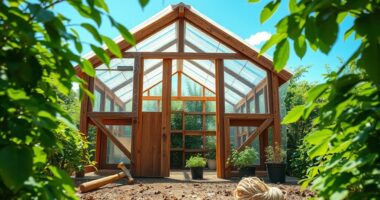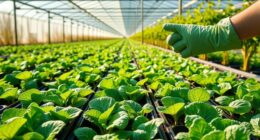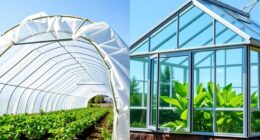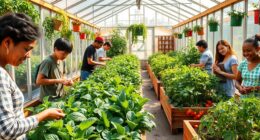When choosing the best location for your greenhouse, you’ll want to maximize sunlight by positioning it to face south or southeast. Make sure it’s accessible from your home for easier maintenance. Check the ground for stability and proper drainage to avoid water accumulation. Reflect on environmental factors like wind protection and seasonal adjustments to maximize light exposure. With the right planning, your greenhouse can thrive, and there’s much more to reflect on in creating an ideal setup.
Key Takeaways
- Position the greenhouse to face south or southeast for optimal sunlight exposure throughout the day.
- Ensure the location is close to your home for easy access and maintenance.
- Select a stable, well-drained ground to prevent structural damage and promote healthy plant growth.
- Protect the greenhouse from prevailing winds using natural barriers like trees or shrubs.
- Incorporate utilities like electricity and water supply to enhance greenhouse efficiency and facilitate gardening tasks.
Optimal Sun Exposure
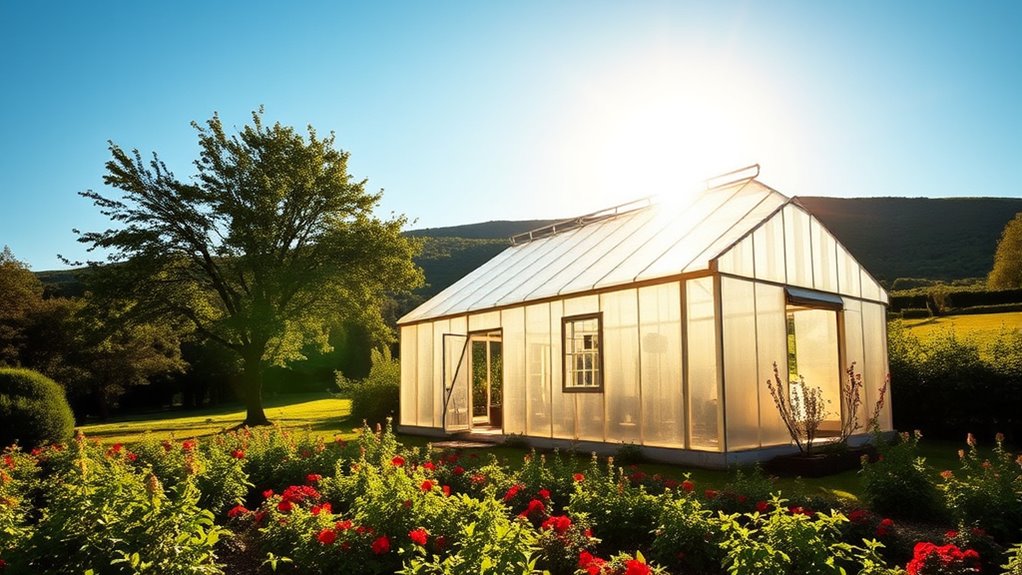
When you choose a location for your greenhouse, ensuring ideal sun exposure is essential for healthy plant growth. Aim for at least 6-8 hours of direct sunlight daily.
Position the longest side of your greenhouse facing south or southeast to maximize sunlight absorption. Be mindful of seasonal changes in the sun’s angle and avoid placing your greenhouse near trees or buildings that could cast shadows.
Using sun path charts can help you pinpoint the best orientation and avoid frost pockets. If your area lacks natural light, consider adding supplemental grow lights.
Accessibility and Convenience

When choosing a greenhouse location, think about how close it’s to your home for easy access during your daily routines.
Well-designed pathways and utility access can greatly streamline your gardening tasks and maintenance. A convenient setup not only saves time but also enhances your overall gardening experience.
Proximity to Home
A close greenhouse is a game-changer for any gardener. It makes caring for your plants a breeze, allowing you to tend to them regularly without hassle.
With the greenhouse just steps away, you can enjoy year-round gardening in a controlled environment. Plus, sharing a wall with your home helps maintain stable temperatures, lowering heating costs.
You can also use the space for other purposes, enhancing your home’s functionality. Easy access to electricity and water simplifies maintenance, while reducing travel time boosts your gardening efficiency.
Frequent visits lead to healthier plants and integrate gardening seamlessly into your daily routine, promoting a healthier lifestyle. With everything within reach, you’ll find that gardening becomes more enjoyable and productive.
Pathway Design
Choosing the right pathway design is essential for making your greenhouse accessible and convenient. Use materials like pavers, bricks, or concrete to create a sturdy, slip-resistant surface.
Aim for a minimum width of 36 inches, but 48 inches or more offers better mobility. Curved paths are easier for navigation, and regular turning platforms help wheelchair users maneuver comfortably.
Guarantee your pathways have a maximum slope of 5% and a cross slope of 2% to prevent slipping. Incorporate seating areas and keep the pathways clear of obstructions to enhance accessibility.
Utility Access
Utility access is essential for guaranteeing your greenhouse operates efficiently and conveniently.
Locate your greenhouse near power sources to simplify installing electrical systems like heaters and grow lights. Easy access to a water supply is vital for effective irrigation and plant hydration.
Centralized utility systems can enhance management efficiency, making maintenance less of a chore. If you ever find yourself far from existing utilities, temporary solutions like extension cords and hoses can help.
Keep your greenhouse close to your home for easy maintenance and reduced labor needs. Additionally, confirm there’s enough space for transporting supplies.
Ground Stability and Drainage

Ground stability and effective drainage are vital elements for a successful greenhouse setup. You need stable ground to prevent structural damage and keep your greenhouse level. Shifting ground can lead to uneven settling, compromising its integrity.
Before construction, make certain to compact the ground and design a foundation that distributes weight evenly. This will enhance structural resilience, especially against harsh weather.
Ensure you compact the ground and create an even foundation to bolster your greenhouse’s strength against severe weather.
Additionally, proper drainage is important; poor drainage can cause water accumulation, leading to mold and damage. Grade the ground for a 6-inch drop over 100 feet to guarantee effective water flow.
A level surface will also help maintain stable construction and a balanced microclimate, so pay attention to these factors during your site preparation.
Environmental Factors

When selecting a greenhouse location, consider wind protection strategies to shield your plants from harsh gusts that can cause damage.
Additionally, effective pest management is essential to keep your crops healthy and thriving.
Understanding these environmental factors will help you create a more resilient growing environment.
Wind Protection Strategies
To effectively protect your greenhouse from wind, it’s essential to implement several strategic measures.
Start by using natural barriers like trees or fences to reduce wind speed. Position your greenhouse so that its smallest side faces the prevailing wind, minimizing impact. Incorporate windbreaks such as conifer trees or shrubs to deflect wind over the structure.
Reinforce your greenhouse with cross bracing and roof bracing for added stability against gusts. Regularly inspect for loose debris and weak structures to prevent damage.
Finally, consider the local wind patterns and choose a sheltered location to further enhance protection. By taking these steps, you can create a more resilient environment for your plants.
Pest Management Considerations
Wind protection strategies set the stage for a thriving greenhouse environment, but managing pests is equally important for your plants’ health.
To keep pests at bay, consider these environmental factors:
- Temperature Control: Maintain ideal temperatures to reduce plant stress and prevent pest outbreaks.
- Humidity Management: Use ventilation to lower humidity levels, minimizing fungal diseases and pest proliferation.
- Soil Conditions: Regularly monitor soil pH and electrical conductivity to avoid overfertilization, which attracts pests.
- Air Circulation: Guarantee good air circulation to decrease the risk of fungal diseases and pest infestations.
Utilities and Infrastructure

Choosing the right utilities and infrastructure for your greenhouse is essential to its success, as it directly impacts efficiency and operational costs. You’ll want to guarantee adequate electrical service, which varies based on your greenhouse size. Installing a single electrical service can save you from multiple base charges. Don’t forget about water supply; an automatic watering system can be a game-changer.
Here’s a quick overview of key considerations:
| Utility | Considerations |
|---|---|
| Electrical Service | Size, grounding, distribution systems |
| Water Supply | Adequate supply, quality, and drainage |
| Access to Utilities | Proximity, electricity availability, fuel access |
| Transportation | Good roads, market proximity |
With careful planning, you can set up a greenhouse that thrives.
Future Expansion Considerations
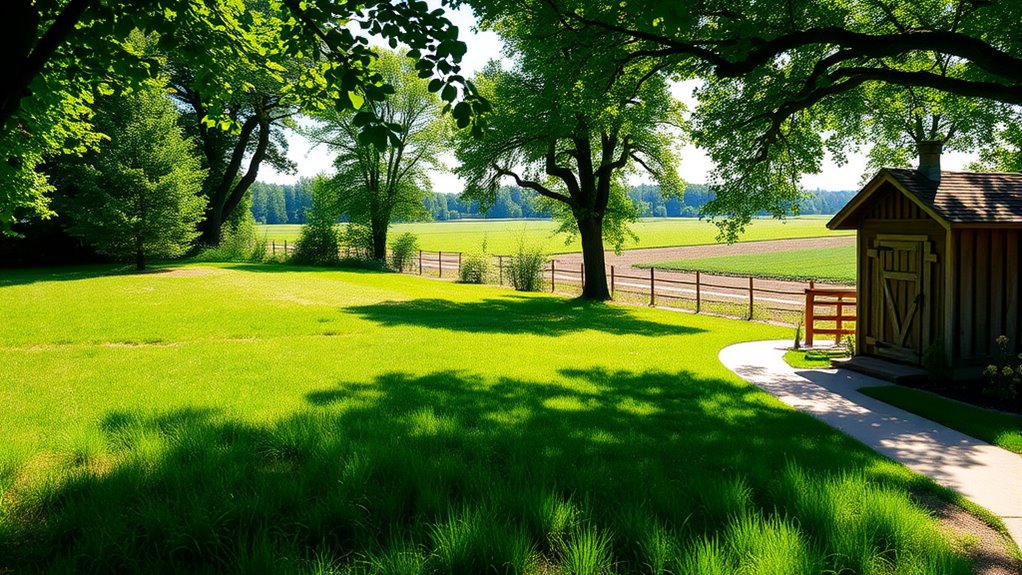
As your greenhouse operation grows, planning for future expansion becomes essential to maintaining efficiency and sustainability. Here are some key considerations to keep in mind:
- Land Acquisition: Buy more land than you need now to guarantee room for growth without disrupting current operations.
- Space Allocation: Design your site with enough space for future additions and increased resource demands, considering local ecosystems.
- Environmental Impact: Choose sustainable materials and energy-efficient systems to minimize your ecological footprint as you expand.
- Regulatory Compliance: Stay informed about local zoning laws and obtain necessary permits, making certain your expansion adheres to legal requirements.
Seasonal Sunlight Adjustments
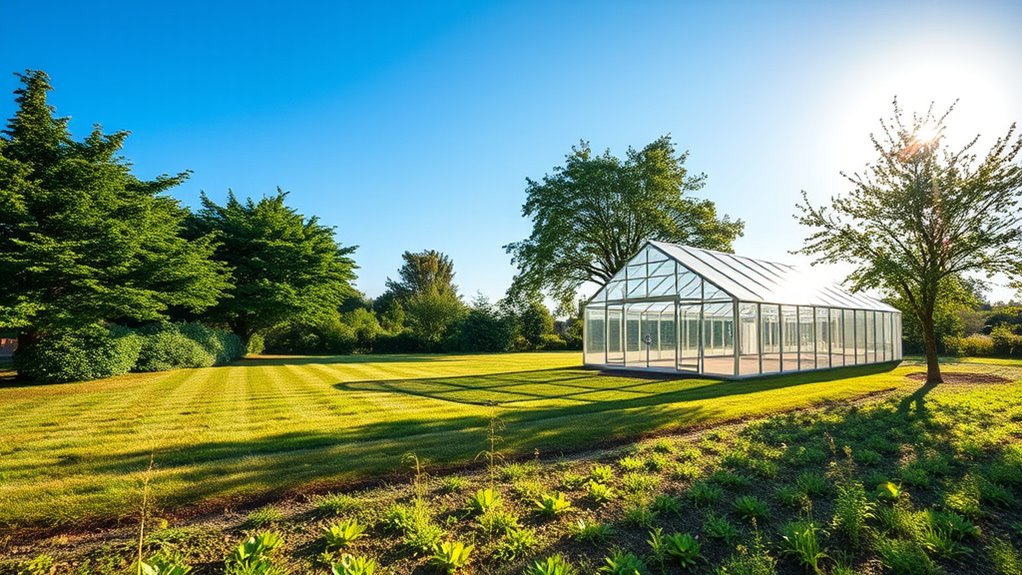
When it comes to seasonal sunlight adjustments, regularly adjusting your greenhouse’s orientation can make a big difference in maximizing light exposure.
You’ll also want to keep an eye on seasonal lighting variations and how shadows from nearby structures or trees might impact your plants.
Adjusting Orientation Regularly
While it might seem beneficial to adjust your greenhouse’s orientation regularly to maximize sunlight exposure, practical limitations often make this impractical.
Most greenhouses are designed with a fixed orientation, typically facing south, to capture sunlight efficiently. Instead of frequent adjustments, consider these alternatives:
- Use Reflective Materials: Adding reflective surfaces can enhance light distribution without moving the structure. This is similar to how color accuracy impacts overall image quality in projectors.
- Implement Supplemental Lighting: Grow lights can boost sunlight during less ideal periods, particularly when seasonal sunlight adjustments are necessary. Additionally, utilizing solar energy for these lights can further reduce energy costs and enhance sustainability. Moreover, using an energy-efficient heating system can help maintain optimal temperatures in your greenhouse, contributing to long-term energy savings.
- Optimize Roof Angle: Adjusting the roof angle during construction can maximize winter sunlight.
- Incorporate Shading: External shades can help manage excessive sunlight, ensuring your plants thrive year-round.
Focusing on these strategies allows you to maintain favorable conditions without the hassle of changing your greenhouse’s orientation. Additionally, ensuring proper refrigerant management in your greenhouse heating system can also contribute to a more energy-efficient environment.
Seasonal Lighting Variations
Understanding seasonal lighting variations is essential for optimizing plant health and growth in your greenhouse. Light intensity fluctuates throughout the year, peaking in summer and dipping in winter. The sun’s angle changes, impacting how much light your plants receive.
During spring, plants ramp up their photosynthesis as daylight increases, while growth slows in fall. To adapt, consider using shade cloths in summer to prevent overheating and removing them in winter to maximize light exposure.
You might also need supplemental lighting in winter months to sustain growth. Adjusting watering and fertilization schedules according to these seasonal changes guarantees your plants thrive, helping you achieve a successful greenhouse environment year-round.
Impact of Seasonal Shadows
As the seasons change, the shadows cast by nearby structures can greatly affect the sunlight your greenhouse receives.
These shadows can vary considerably, impacting sunlight exposure by up to four hours daily. To effectively manage this, consider the following strategies:
- Utilize Shadow Analysis Tools: Use sun path charts and 3D modeling software to predict shadow patterns throughout the year.
- Orient for Sunlight: Position your greenhouse with a south or southeast orientation to maximize exposure.
- Assess Microclimates: Identify how shadows create varying temperatures and humidity levels around your greenhouse.
- Plan for Seasonal Adjustments: Regularly reevaluate your setup to guarantee ideal sunlight throughout the changing seasons.
Additionally, understanding backyard greenhouse design principles can help you make informed decisions about shadow management.
Pest Management Strategies

Effective pest management strategies are essential for maintaining a healthy greenhouse environment.
Effective pest management is crucial for ensuring a thriving greenhouse ecosystem.
Start by installing insect netting and screens on air intakes to block pests while promoting airflow. Use yellow sticky traps for monitoring and controlling small flyers like fungus gnats. For minor infestations, hand-pick pests from plants.
Introduce beneficial insects, like parasitic wasps, to manage aphids naturally. If needed, opt for targeted insecticides and rotate them to prevent resistance.
Monitor your greenhouse regularly, keeping sticky card logs to track pest activity. Don’t forget about sanitation; a clean environment reduces pest breeding sites.
Finally, maintain well-drained soil and manage humidity to deter pests, ensuring your greenhouse thrives.
Integration With Existing Gardens
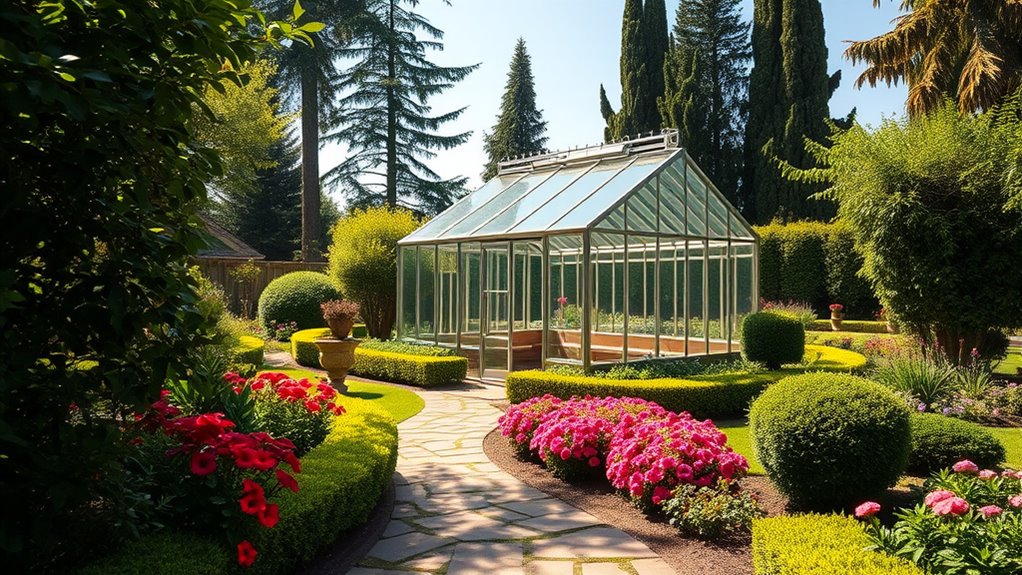
When you integrate a greenhouse with your existing gardens, you create a seamless and efficient gardening experience.
This proximity not only fosters easy transfer of seedlings but also enhances the visual appeal of your gardening space.
Consider these key integration strategies:
- Pathway Design: Create pathways connecting your greenhouse to the garden for accessibility and aesthetic harmony.
- Shared Resources: Position the greenhouse near your garden to share water sources and tools, increasing efficiency.
- Microclimate Benefits: Utilize the greenhouse to create a microclimate, offering shelter and warmth to nearby plants.
- Sunlight Maximization: Verify the greenhouse is positioned to maximize sunlight exposure, supporting ideal plant growth. Additionally, integrating a greenhouse can extend the gardening season, allowing you to cultivate a wider variety of plants throughout the year.
Long-Term Planning and Sustainability
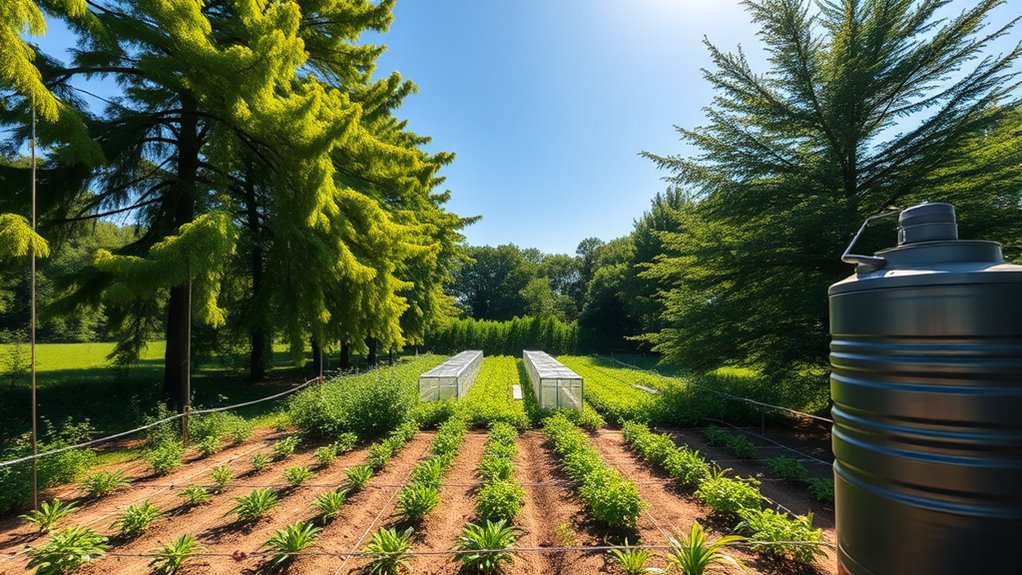
Planning for the long-term sustainability of your greenhouse guarantees it remains a productive and environmentally friendly space for years to come.
Start by implementing renewable energy systems like solar panels to cut costs and reduce your carbon footprint. Incorporate rainwater harvesting to promote self-sufficiency and minimize external water reliance.
Implement renewable energy solutions like solar panels and rainwater harvesting to enhance self-sufficiency and lower environmental impact.
Choose eco-friendly materials, such as reclaimed wood and recycled polycarbonate, to support sustainability. Embrace natural pest control methods, creating a healthier ecosystem without harmful chemicals.
Leave space for future expansion and prioritize durable materials for longevity. Regular maintenance checks will help prevent structural issues.
Frequently Asked Questions
What Materials Are Best for Greenhouse Construction?
When constructing your greenhouse, consider using cedar or redwood for the frame, as they’re naturally resistant to rot and insects.
For covering, polycarbonate is a great choice due to its durability and insulation properties.
A solid concrete base guarantees stability, while interlocking tiles can enhance drainage.
Don’t forget to add ventilation systems and grow lights to create an ideal growing environment for your plants.
These materials will help you achieve a successful greenhouse.
How Do I Maintain Optimal Humidity Levels Inside the Greenhouse?
To maintain ideal humidity levels inside your greenhouse, monitor with hygrometers and adjust as needed.
Use misting systems, humidifiers, or place buckets of water to boost humidity.
For reduction, guarantee proper ventilation by opening windows or using fans, and consider raising temperatures.
You can also minimize watering or install dehumidifiers.
What Are the Best Plants for Greenhouse Gardening?
Did you know that greenhouse gardening can increase yields by up to 300%?
When considering the best plants, think about tomatoes and peppers, which thrive in warm conditions.
Strawberries and cucumbers are also great choices for beginners.
If you’re feeling adventurous, try growing cucamelons or luffas.
For herbs, mint and parsley are easy to cultivate all year.
Choose plants that suit your climate, and watch your greenhouse flourish!
How Can I Control Temperature Fluctuations in My Greenhouse?
To control temperature fluctuations in your greenhouse, use digital thermometers and smart climate control devices for accurate monitoring.
Implement automated ventilation systems to regulate airflow and prevent overheating.
Consider shading techniques and misting systems to cool plants during hot days.
For heating, electric heaters and geothermal systems can maintain warmth.
Finally, utilize thermal mass materials like water barrels to stabilize temperatures, ensuring your plants thrive in ideal conditions.
What Are the Costs Associated With Greenhouse Maintenance?
When considering greenhouse maintenance costs, you should expect to spend between $50 and $200 annually.
Replacement parts, like plastic panels and ventilation systems, can add to these expenses. If repairs are needed, the average cost is around $1,460, although smaller fixes can be as low as $375.
Be mindful of labor costs too, which typically range from $50 to $100 per hour for professional assistance.
Regular upkeep helps minimize these costs.
Conclusion
In choosing the best location for your greenhouse, remember it’s not just about where you plant it, but how it grows with your garden. By considering sun exposure, accessibility, and environmental factors, you’re setting the stage for a flourishing oasis. Like a well-tended seed, your thoughtful planning will sprout into a sustainable space for years to come. Embrace the journey, and watch your greenhouse thrive as an essential part of your gardening adventure.


